

CD19-Targeted T Cells Rapidly Induce Molecular Remissions in Adults with Chemotherapy-Refractory Acute Lymphoblastic Leukemia. Science Translational Medicinestm.sciencemag.org Sci Transl Med 20 March 2013: Vol. 5, Issue 177, p. 177ra38 Sci.
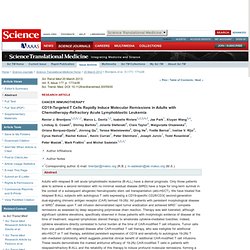
Transl. Med. DOI: 10.1126/scitranslmed.3005930 Research Article Cancer Immunotherapy + Author Affiliations + Author Notes ↵† These authors contributed equally to this work. AbstractBack to Top Adults with relapsed B cell acute lymphoblastic leukemia (B-ALL) have a dismal prognosis. Copyright © 2013, American Association for the Advancement of Science Citation: R. The editors suggest the following Related Resources on Science sites Back to Top In Science Translational Medicine In Science Magazine. Larone syndrome - Google leit. Symptoms of Torn Artery Are Easy to Miss. Photo Karin Satrom, a 35-year-old Brooklynite, had been feeling fine through 23 weeks of pregnancy when one night she said she became “very, very dizzy, as if I were drunk.”

Her husband suggested that she lie down, but even with her eyes closed, the room continued to spin. Still extremely dizzy and seeing double in the morning, Ms. Satrom called her doctor, who sent her directly to New York Methodist Hospital. No pregnancy-related reason for her symptoms was found, but a neurologist suspected a tear in an artery in her neck that supplies blood to the back of the brain. An M.R.I. confirmed the diagnosis, vertebral artery dissection, and showed that the transient ischemic attack, or mini-stroke, she had experienced as a result had left no lasting brain damage. Ms. Now six weeks later, Ms. Dr. Century-old drug reverses signs of autism in mice. A single dose of a century-old drug has eliminated autism symptoms in adult mice with an experimental form of the disorder.
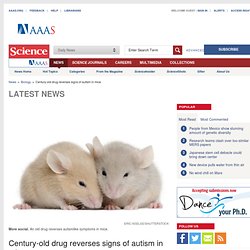
Originally developed to treat African sleeping sickness, the compound, called suramin, quells a heightened stress response in neurons that researchers believe may underlie some traits of autism. The finding raises the hope that some hallmarks of the disorder may not be permanent, but could be correctable even in adulthood. Benign prostatic hyperplasia. Benign prostatic hyperplasia (BPH), also called benign enlargement of the prostate (BEP), adenofibromyomatous hyperplasia and benign prostatic hypertrophy (technically incorrect usage), is a benign increase in size of the prostate.

BPH involves hyperplasia of prostatic stromal and epithelial cells, resulting in the formation of large, fairly discrete nodules in the transition zone of the prostate.[1] When sufficiently large, the nodules impinge on the urethra and increase resistance to flow of urine from the bladder. This is commonly referred to as "obstruction," although the urethral lumen is no less patent, only compressed. Resistance to urine flow requires the bladder to work harder during voiding, possibly leading to progressive hypertrophy, instability, or weakness (atony) of the bladder muscle.
Adenomatous prostatic growth is believed to begin at approximately age 30 years. Signs and symptoms[edit] Benign Prostatic Hyperplasia: American Urological Association. Download the unabridged version of this guideline [pdf] View the webinar associated with this guideline [video]

Adolescent drinking affects adult behavior through long-lasting changes in genes. Binge-drinking during adolescence may perturb brain development at a critical time and leave lasting effects on genes and behavior that persist into adulthood.The findings, by researchers at the University of Illinois at Chicago College of Medicine using an animal model, are reported online in the journal Neurobiology of Disease.
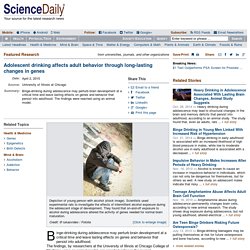
Flu News Europe. Leukodystrophy. Leukodystrophy is one of a group of disorders characterized by degeneration of the white matter in the brain.[1] The word leukodystrophy comes from the Greek roots leuko, white, dys, lack of, and troph, growth.
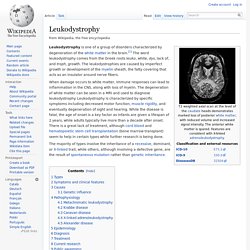
The leukodystrophies are caused by imperfect growth or development of the myelin sheath, the fatty covering that acts as an insulator around nerve fibers. When damage occurs to white matter, immune responses can lead to inflammation in the CNS, along with loss of myelin. The degeneration of white matter can be seen in a MRI and used to diagnose leukodystrophy. Leukodystrophy is characterized by specific symptoms including decreased motor function, muscle rigidity, and eventually degeneration of sight and hearing.
While the disease is fatal, the age of onset is a key factor as infants are given a lifespan of 2 years, while adults typically live more than a decade after onset. Types[edit] Symptoms and clinical features[edit] Causes[edit] Genetic influence[edit] Pathophysiology[edit] Ancient Drug Meets Personalized Medicine. It’s pretty amazing to me that we’re still discovering new uses for a drug as old as aspirin.
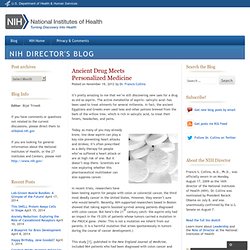
The active metabolite of aspirin—salicylic acid—has been used to treat ailments for several millennia. In fact, the ancient Egyptians and Greeks even used teas and other potions brewed from the bark of the willow tree, which is rich in salicylic acid, to treat their fevers, headaches, and pains. Today, as many of you may already know, low-dose aspirin can play a key role preventing heart attacks and strokes; it’s often prescribed as a daily therapy for people who’ve suffered a heart attack or are at high risk of one.
But it doesn’t stop there. Scientists are now exploring whether this pharmaceutical multitasker can also suppress cancer. In recent trials, researchers have been testing aspirin for people with colon or colorectal cancer, the third most deadly cancer in the United States. The Lancet - Global burden of cancer in 2008: a systematic analysis of disability-adjusted life-years in 12 world regions. Introduction Information about fatal and non-fatal cancer-related outcomes is needed to establish priorities in cancer control.
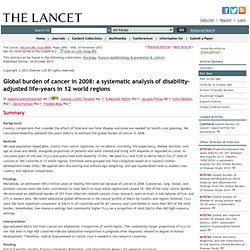
Disability-adjusted life-years (DALYs) are a key measure for such purposes because they link the burden of cancer mortality with the degree of illness and disability in patients and long-term survivors.13 We present DALYs and their two components—years of life lost because of premature mortality (YLLs) and years lived with disability (YLDs)—for 27 cancers sites, separately and combined, for 184 countries and 12 world regions in 2008. We took account of global indicators of human development. Results Age-adjusted DALY rates per 100 000 population by cancer site and region, 2008 Age-adjusted DALYs by world region Total DALYs and the five cancers that contributed most to the total for each region. Age-adjusted DALYs per 100 000 population by cancer site and level of HDI. New cancer treatment uses patient's cells to attack disease.